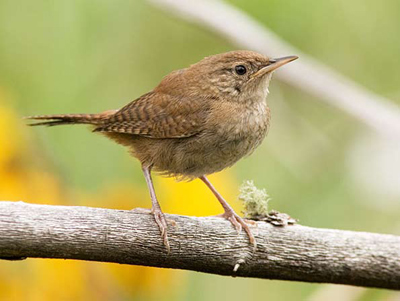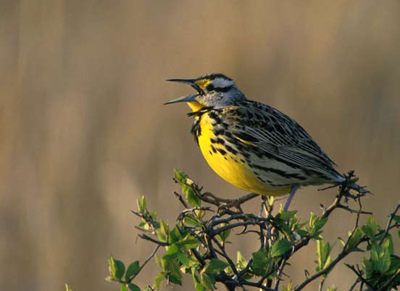Methods

© Robert Shantz
The Kansas Natural Heritage Inventory conducted breeding bird surveys in May and June 2001. Fort Larned National Historic Site (NHS), located in central Pawnee County, Kansas, is comprised of developed areas, grassland, and the Pawnee River lined by a wooded riparian corridor. A detached 44-acre parcel consists of native mixed-grass prairie. Prior to this fieldwork, no inventories of birds on Fort Larned NHS existed so lists of birds were compiled based on the best available resources (e.g., Kansas Natural Heritage Inventory databases, museum specimens, books/guides, and knowledgeable staff). Bird surveys were conducted on four different days in woodland, developed areas, and grasslands for a total of 22 person-hours of survey time.
Status

© J. & K. Hollingsworth
Fifty-seven bird species were documented during surveys for breeding birds. These include the red-tailed hawk (Buteo jamaicensis), great horned owl (Bubo virginianus), downy woodpecker (Picoides pubescens), common nighthawk (Chordeiles minor), black-capped chickadee (Poecile atricapillus), house wren (Troglodytes aedon), Eastern and Western meadowlark (Sturnella magna and S. neglecta), and American goldfinch (Carduelis tristis). All of these species were noted as common in abundance. Ten species were confirmed to be breeding at the site during the survey period.
Using a revised (based on project results) master species list for birds, 57 of 78 (73%) of the expected species have been documented at Fort Larned NHS. Bird species that were detected are common birds of grasslands and woodland edge. The woodlands are especially important to the diversity of birds with species associated with trees accounting for 48 of the 57 species (84%) encountered in the park. However, grassland birds are the most numerous due to the preponderance of grassland habitat.
Several species not detected in Pawnee County during the Kansas Breeding Bird Atlas project were identified during this survey. These are the Eastern screech owl (Megascops asio), Eastern wood-pewee (Contopus virens), Eastern bluebird (Sialia sialis), gray catbird (Dumetella carolinensis), spotted towhee (Pipilo maculatus), and indigo bunting (Passerina cyanea). The belted kingfisher (Megaceryle alcyon) was observed at the fort in April and may be present during the breeding season, but was not detected then. In addition, the barn owl (Tyto alba) was not detected during this study but was reported by park staff to have been present in previous years. The great-tailed grackle (Quiscalus mexicanus), known to breed in central Kansas, also was observed in April but not during the breeding season. This is a relatively common species for the area although it was not detected in the county during the Kansas Breeding Bird Atlas project. Additional breeding and non-breeding bird surveys are recommended at Fort Larned NHS.
Contacts
Jennifer M. Delisle and William H. Busby, Kansas Natural Heritage Inventory
Reference
Delisle JM and Busby WH. 2004. Biological Inventory for Vertebrates at Fort Larned National Historic Site of the Southern Plains Network.
Prepared by the Southern Plains Network Inventory and Monitoring Program, 2015.
Part of a series of articles titled Southern Plains Bird Inventories.
Previous: Chickasaw Breeding Bird Inventory
Last updated: February 1, 2017
